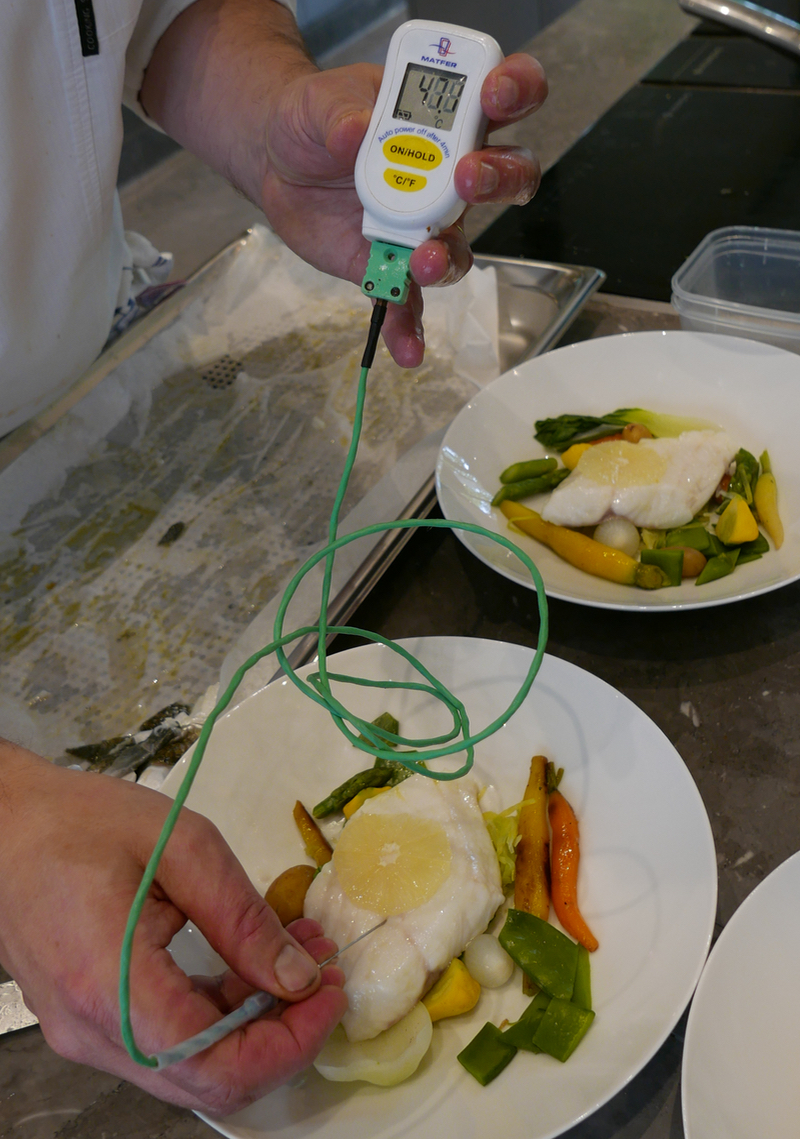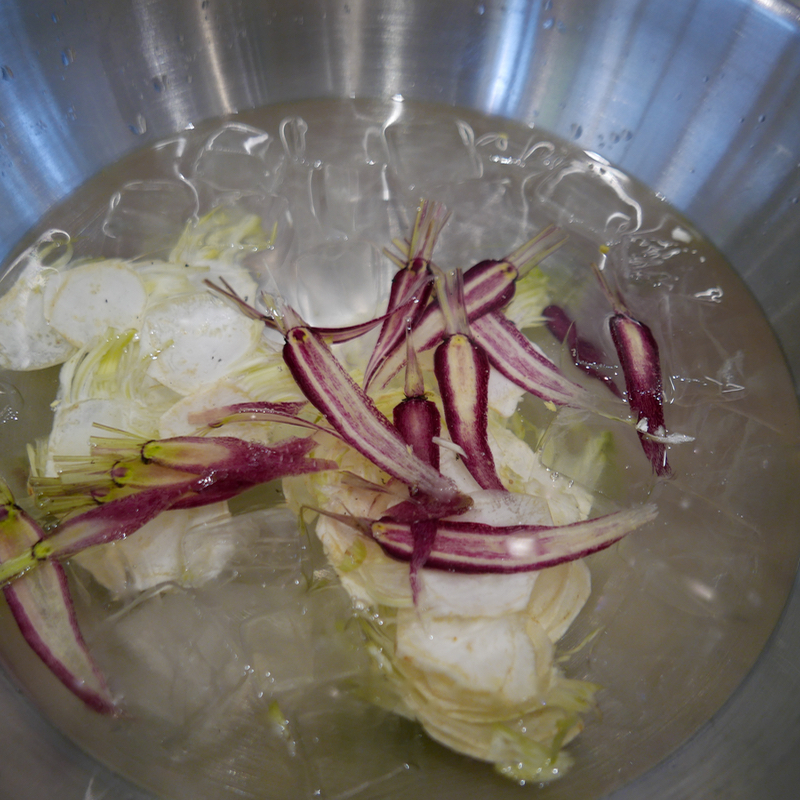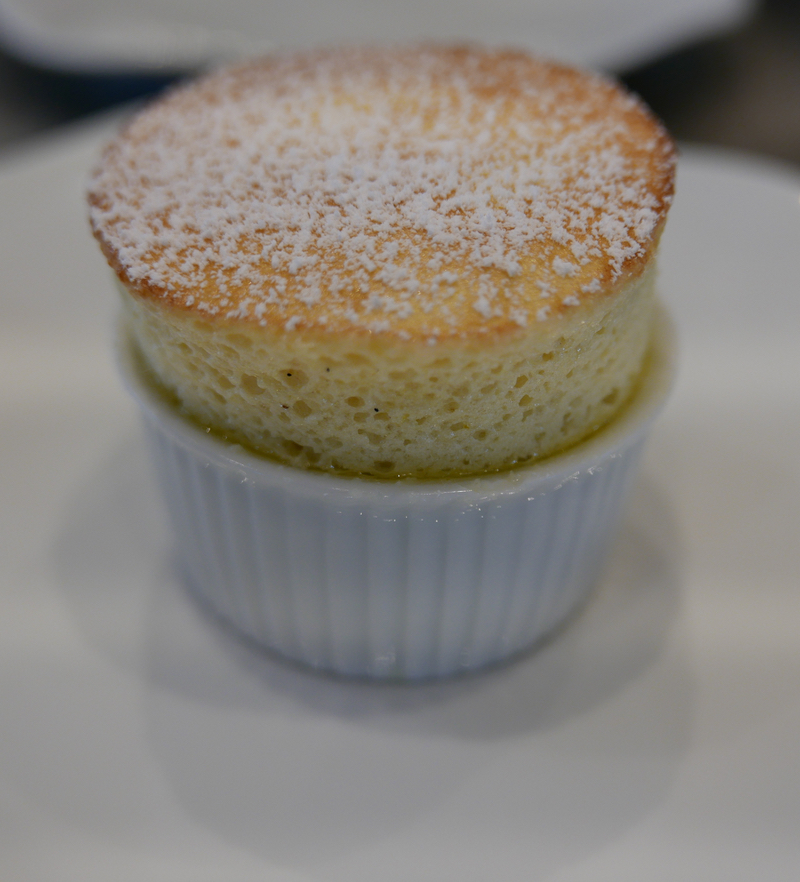Cooking French food: rustic, gastronomic and slimming cuisine of Michel Guérard
Cooking French food like Julia Child still sounds romantic to any home cook’s ear. Yet, we are in the twenty-first-century so let’s get the wisdom of the lifelong experience from one of the biggest chefs France has today. For forty years three Michelin stared Michel Guérard offers plenty of cooking classes at his culinary school in Eugénie-les-Bains.




The zen ambiance of the newly built kitchen makes cooking relaxing. As if the bamboo forest on one side and the French garden canvas lining outside the other wall were to remind you that cooking French food is about joy, the pleasure from preparing food from the gifts of nature. Adjoining the kitchen with about six-eight cooking stations is a dining room, where you later enjoy the fruits of your labour, and a small village café owned by the chef’s family.
Equipped with the recent culinary technology, the Institut Guérard and School of Cooking contrasts with the basic, traditional equipment in the chef’s home kitchen and the gastronomic restaurant nearby. Nevertheless, it is exciting to have an access to and to learn how to use the Thermomix (cooking and mixing at a set temperature), Pacojet (homogenising frozen ice creams and sorbets, whipping cream), vacuum cooking (evenly cooking meat) or measuring precisely the temperature of your protein with a needly thermometer, especially since these gadgets cost thousands of Euros and in so are inaccessible to a typical home cook. Even if you will never use them again, trying to be like the contemporary gastronomic chef for a day or more feels empowering and frustrating at the same time. Will I ever be able to cook that sea bass so perfectly? Without having an oven measuring the precise inside temperature of the flesh without the need to open the door, my only choice is to stick my handy home thermometer in the fish once now and then (49-50°C » 120-122°F is ideal) as Stéphane Mack has done again once we too the fish out of oven.



Cooking French food: rustic, gastronomic and slimming cuisine of Michel Guérard
Within four days, plus the Michel Guérard country house and winery visit on day five, you can learn all three culinary styles, plus pastry of one of the longest Three Michelin stars holding living chefs today. The rustic (traditional country farmhouse food), gastronomic (his Three Michelin star recipes) and minceur (slimming) cuisine of Michel Guérard is taught by Stéphane Mack at the Institut Guérard on a pre-scheduled basis each year. Most of the courses are professional training in the chef’s famous cuisine minceur, but shorter classes for the curious food loving cooks, who want to develop their kitchen skills, learn more about contemporary kitchen gadgets available to many of the best restaurants, and above all perfect some known and peculiar French recipes run from a half day up to a week. Tricks like cooking life lobster easily, how the guts of shrimps can be pulled out with a toothpick, reconstituting gelatine and more come handy. Read bellow how to bake the perfect soufflé.


You will not get much information ahead of the class week, but the schedule tends to run in the following order.
The first day our theme was traditional rustic cuisine, the country style at the Ferme des Grives farmhouse in Eugénie-les-Bains. My insight from eating there the previous night, the leftovers of which were still burbling in my stomach, precautioned me that plenty of cream, butter and very likely foie gras will be used. Three recipes on our program: an easy starter of Tomato and strawberry gazpacho with herb sorbet, main course of Chicken wrapped in bacon, stuffed with cream cheese and foie gras (minceur version is published in his book), a side dish of gratin penne pasta in a heavy cep cream (hence the painful pangs from the previous night!), and a dessert of new chocolate soufflé with Armagnac ice cream. We got dead chickens with their heads still on, all to be individually handled by each of us. The chef guided us to perfectly clean the chicken, a messy job, but now I know how it is properly done. I prefer handling the vegetables though and their time came later on day two.


If you discuss ahead with the teaching chef, additional recipes can be demonstrated, or with all-hands-make-one-recipe prepared.
Cooking French food in traditional, heavily butter and cream dependent style of the chef Guérard is well covered in the selected recipe book from the Alain Ducasse Edition of The Best of Michel Guérard. There in detailed photography you learn how to cut and stuff the chicken properly so you can have a go at the comfort of your home kitchen without traveling.
Perfecting French soufflé
I have baked a chocolate soufflé at chocolate baking class in New York, so I knew that not opening the oven before the dough rises is one of the secrets to success, but now I learned that thanks to the cocoa butter in the batter, this is the rare recipe that can be made ahead and stored in the fridge until before baking. Any other soufflés must be made à la minute. A late eighteenth’s century french speciality, the soufflé became the theme of our cooking week. We prepared three other versions – Apricot, Verbena (an experiment of baking whipped eggs flavoured with verbena to top the millefeuilles) and Grand Marnier (upon request of a trio of Swiss-German male foodies). I disclose one trick here, when buttering the baking dish, smother the butter on the top edges as well and flour, it will prevent the soufflé from running out to the sides and assists it going up evenly. If you did not have enough of the fluffy hat pastry, then get the savoury roquefort version in the gastronomic restaurant. You will set yourself for an enlightening journey into the lightly raised, fragile pastry that many chefs admire.


Cuisine minceur or the gastronomic slimming cuisine Michel Guérard pioneered in 1970s long before any Michelin chef considered health on their plate, came to our menu on day two. Unless you take one of the classes at the Michel Guérard Institute for Health Professionals ® his newest book Eat Well and Stay Slim offers a better foundation, plus many more recipes than is included in the short class. Still, some tricks are reserved only for the eye witnesses.
Delicate vegetable terrine made from seared vegetables without an egg or gelatine, simply by squashing it tightly in a form was a revelation. Simple, but succulent.
Although I was not keen on most of the minceur desserts, the simple Peaches in lemon verbena jelly, light lemon mousse was exquisite. We used xylitol and fruit juice to sweeten it and animal gelatine, but agar agar can be substituted as the chef advised. Further, the aromatic vegetable stock we prepared was the tastiest ever. It takes almost three hours to chop, grate, simmer and infusing so we jumped into the preparation right at 9am. The secret ingredients making the stock so exotically fragrant were fresh ginger, star anise and orange (peel and separately slices with pith removed) and lemon infused in it after two hour of light cooking. Kaffir lime was not part of the recipe, but adding this Reunion island leaf made the stock even more fragrant. Covering the whole batch with a circle of baking paper kept more vitamins.
The stock was the foundation for our main course – perfectly Poached sea bass with garlic, teriyaki, vegetables and herbs. The chef demonstrated filleting of the two large fishes, so we could not take any credit for the sublime result turning to be my favourite plate of the week. It was a pity that we were not allowed to do it ourselves as we did the chicken on day one and the bloody pigeon on day three, since personally, I would prefer the fish to pigeon. The technique for descaling, de-gutting and filleting the fish is very different from butchering meat or birds.



We were firmly set to become bird and soufflé baking experts.
By day three we were ready to tackle the gastronomic cuisine by Michel Guérard. To plate pretty, various tools are used – an adjustable ring for dome shaped tartare, sticky border mats to put on plate when plating sauce with The moonlight fishermen’s drunken lobster (then you just peel it off and as the sauce sets it will stay in place), deep-fry the empty lobster shells if you want to bring their bright colours up for presentation. Wearing tight fitting gloves is advisable when handling most of the gritty kitchen stuff. Extra, we made shrimp and mango spring rolls wrapped in store-bought thin pastry sheets. Rolling and wrapping them perfectly was one technique I mastered that day.


Carnivore’s dilemma in the kitchen
I did not learn one thing though. As my stomach started to turn upside down when seeing the dead carcasses of pigeons, I handed my bird to my kind Australian translator (classes are in French with optional local translator available), and headed out to check out the farmers market outdoors (Wednesdays). There, the plentiful presence of foie gras reminded me that this local delicacy is not less cruelly produced than the three weeks old pigeons that are strangled and hanged so their meat remains tender. This shocking experience brought ethical questioning to my mind, and sincerely, I was considering to become vegetarian. If I cannot handle meat from killing the animal through cleaning the dead body, chopping its limbs, heads and cutting its fingers off, how can I eat meat? A life-changing experience indeed. One thing is sure, I did not like pigeon meat before and I was even more adamant not to eat it any more in the future, unless I get exposed to death and life situation. The rest of my class continued in the unenviable task of portioning and de-gutting the bird even though some did not eat it or did not enjoy eating it, so even if you are not exactly a pigeon connoisseur, this class may be very practical.
Cooking French food would not be complete without pastry. The last cooking day culminates in the award winning (Meullier Ouvrier de France) pastry chef’s artistry. Michel Guérard’s sweet treasures such as the classic and simple Strawberry Charlotte celebrating the strawberry peak season at the dawn of summer was served at the farmhouse, but we whipped our own To my disappointment we used a store-bought finger biscuits, the chef saying that“the ingredients are exactly the same as our recipe and there are no additives, preservatives, …”. To me they were simply not freshly made, but it saved us time and the creamy fluffy dessert was lips licking!



Then came Crusty poached apricot millefeuille, light cream flavoured lemon verbena. Again we used a store-bought puff pastry, that the chef rolled out, sliced in rectangles and put in the oven to bake. One thing we learned though, do not keep the fan in the oven on, otherwise your millefeuilles will take all wild shapes imaginable. Save for one, the rest of our puffed pastries needed to be camouflaged with plenty of the irresistibly ravishing verbena crème anglaise. We also whipped a Floating island flavoured with lime from the minceur cuisine. Sweetening it with xylitol (dehydrated silver birch sap with very low GI and good for teeth) instead of the available overly processed Canderel was a welcome move, but still, despite the use of heavy cream to balance pleasure, this was everyone’s least favourite dessert.



The nine to two thirty timetable is only a guidance, since every day we got to that happy eating part just after three in the afternoon, often leaving the school around four. Time for a siesta and perhaps a refreshing or relaxing spa treatment? The beautiful country spa house is an ideal balance after standing most of the day on two feet. Your back and knees will need some serious rejuvenation. Thermal water bubble bath, warming joints soothing wrap or diving into the muddy flotation in the signature clay bath is like a well in the dessert when you have been traveling all day without a sip.
Since the lunches are quite late, it helps to know what you will be cooking and eating each day to plan your dinners. There are not many dining options in the region, so you will probably eat every night either at the gastronomic restaurant, at the farmhouse or the cuisine minceur three course menu. Balancing each day will lead to your better enjoyment. I would recommend eating at the farmhouse on the cuisine minceur cooking day, because the rustic French food is very heavy. The gastronomic restaurant can be more closely understood if you eat there after making it for lunch. And when you bake the ultra creamy pasta with foie gras and cheese stuffed chicken, then a room service may suit you best.


Eating at all three restaurants by Michel Guérard during your stay will certainly help you to better understand the food of the celebrated French chef, but cooking it moves anyone a step or two ahead. Knowing what ingredients and techniques are used in traditional and the more contemporary gastronomic French cuisine, while comparing the recipes with the chef’s cuisine minceur broadens any cook’s understanding of what is possible with one’s plate. Cooking French food can feel nostalgic, this was a truly enlightening class for all of the six participants.
List of Cooking French food classes at the Culinary School:
- 5-day courses (14h lessons):
- Full days (7h of course including 1 lunch): “Best Of Michel Guérard”
- Half-days (3h30): Pastry all in Chocolate, Party Menus, Foie Gras & Terrines, Mushrooms

